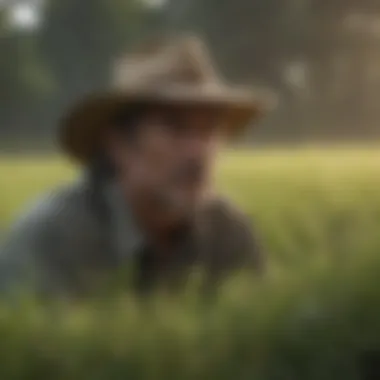Understanding Southern Grass Types and Their Management


Intro
Understanding southern grass types is essential for effective land management and optimal landscaping. This segment introduces the varieties of grasses that thrive in southern climates and the key factors influencing their growth. The information aims to equip farmers, horticulturists, and gardening enthusiasts with insights into selecting suitable grass species based on specific environmental conditions.
Southern regions generally experience a warm climate, which shapes the characteristics of grass types. Grass choices are not only about aesthetics but also about sustainability, resilience, and maintenance requirements. The subsequent sections will delve into the types of grass commonly found in these areas, their unique traits, and management practices that can enhance their health and longevity.
Through this guide, readers can expect to gain a broader perspective on the intricate relationship between grass types and their environments, guiding them towards informed decisions in their landscape planning and agricultural practices.
Preface to Southern Grass Types
Southern grass types are pivotal for effective landscape management in warmer climates. The introduction of this topic is more than just a preamble; it sets the stage for understanding the unique characteristics and growing conditions of various grasses suitable for southern regions. Farmers, horticulturists, and gardening enthusiasts benefit from this knowledge, as it aids in selecting appropriate grasses that can thrive under specific environmental constraints. For instance, understanding the different grass types can significantly impact soil health, water usage, and overall lawn performance.
Definition and Importance
Southern grasses refer to a group of grass species that thrive in the warmer, more humid climates of southern regions. These grasses are essential for various reasons:
- Adaptation: They are adapted to handle high temperatures and periods of drought, making them resilient choices for landscaping in southern climates.
- Erosion Control: Many southern grass types are effective for preventing soil erosion, a common issue in areas with heavy rainfall.
- Biodiversity: Implementing a diverse range of grass species promotes ecological balance by supporting different wildlife habitats.
Their importance is underscored not only in agricultural settings but also in residential landscaping. Choosing the right grass can enhance the aesthetic appeal while minimizing resource usage.
Climatic Conditions in Southern Regions
The climatic conditions in southern regions play a critical role in the viability of different grass types. The hot, humid environment influences several factors:
- Temperature: Southern states typically experience higher average temperatures, which affects grass growth cycles. Grasses that peak in heat tolerance are more favorable.
- Rainfall Patterns: Precipitation can vary significantly. Grasses like Bermudagrass thrive in well-drained, sunny areas, whereas species like Tall Fescue might perform better in slightly wetter soils.
- Soil Types: The region’s soil composition, whether sandy, clayey, or loamy, affects moisture retention and nutrient availability. Proper soil management is crucial for grass health.
Understanding these climatic elements is vital. This knowledge enables better planning and more sustainable practices in grass management.
Types of Southern Grasses
Understanding the types of southern grasses is crucial for effective landscape management. Each grass type has unique characteristics, benefits, and considerations for optimal growth. This knowledge allows farmers, gardeners, and horticulturists to select the right grass for their specific climate and purposes.
Bermudagrass
Characteristics
Bermudagrass is a warm-season grass known for its fine texture and dense growth. This characteristic makes it a popular choice for sports fields and lawns. It is adaptable to a variety of soil types but thrives best in well-drained, sandy soils. Its rapid growth allows it to recover quickly from wear and damage, making it a favorable option for high-traffic areas. Also, Bermudagrass has strong rooting systems which contribute to its resilience.
Optimal Conditions
For optimal growth, Bermudagrass requires full sun and can tolerate drought conditions. It grows best when temperatures exceed 75°F. One should note that its need for warm temperatures can limit its cultivation in cooler southern areas. Additionally, it prefers a soil pH between 6.0 and 7.0. This specificity means growers must sometimes amend their soil before planting to ensure the best conditions for Bermudagrass.
Common Uses
Bermudagrass is commonly used in lawns, golf courses, and as pasture for livestock. Its robust nature makes it a practical choice for athletic fields as well. However, its aggressive growth can lead to it overtaking other grass types if not managed carefully. This quality can be both an advantage and disadvantage, depending on the landscape needs.
Zoysiagrass
Characteristics
Zoysiagrass is another warm-season grass that boasts a thick carpet-like texture. Its vigorous growth leads to a dense lawn that provides excellent weed suppression. Zoysiagrass can adapt to various soil types and has a notable resistance to drought. This characteristic makes it popular for residential landscapes where less maintenance is desired.
Optimal Conditions
Zoysiagrass grows best in full sunlight but can tolerate light shade. It prefers a slightly acidic to neutral soil pH, ideally between 6.0 and 7.0. Its ability to withstand moderate drought conditions allows it to be a sound choice for areas with variable rainfall. However, it needs warm temperatures to thrive, and may go dormant in cooler months.
Common Uses
This grass type is widely used in residential lawns, golf courses, and some commercial landscapes. Its dense growth makes it suitable for high-traffic areas, providing both aesthetic appeal and durability. Users should be cautious, however, as it can be slower to establish than other types.
Tall Fescue
Characteristics


Tall Fescue is a versatile grass type with a coarse texture and deep root system. This characteristic allows it to survive in a range of conditions, including heat and drought. It is particularly favorable for transitional zones and has a unique advantage due to its adaptability to both cool and warm climates.
Optimal Conditions
Tall Fescue thrives in full sun to partial shade, and it flourishes with moderate amounts of water. Its preference for a slightly alkaline soil pH of around 6.0 to 7.0 makes soil testing vital before planting. This adaptability permits plant growth across various soils, though it excels in well-drained, fertile soils.
Common Uses
Commonly, Tall Fescue is utilized in residential lawns, parks, and athletic fields. Its drought resistance makes it appealing for regions with limited water supply. However, depending on local climate conditions, Tall Fescue may need more frequent maintenance than some more hardy grass types.
Buffalograss
Characteristics
Buffalograss is a native grass that exhibits a fine texture and a low growth habit. This characteristic enables it to require less mowing than other grass types. It is a warm-season grass and highly resistant to drought, making it a sustainable choice for southwestern areas.
Optimal Conditions
Buffalograss prefers dry, well-drained soils and thrives in full sun. Its optimal soil pH ranges from 6.0 to 7.5. While it can survive in marginal soils, its growth is best supported by fertile conditions. Understanding that it grows slowest in cooler temperatures can inform timing for planting.
Common Uses
This grass type is often used in low-maintenance lawns, prairie restorations, and as ground cover on golf courses. Its sustainability traits add appeal for eco-conscious gardeners. On the downside, Buffalograss may not be suitable in part shade or excessively wet areas.
Comparative Analysis of Grass Types
The comparative analysis of southern grass types is a vital part of understanding how different species thrive under various conditions. This section helps in identifying the inherent qualities of each grass type, which is essential for farmers and enthusiasts aiming to achieve optimal growth and utility from their landscapes. By evaluating grasses on specific parameters such as growth patterns, water requirements, pest and disease resistance, and longevity, one can make informed decisions about which grass type to cultivate. This understanding fosters better management strategies tailored to the unique conditions of southern regions.
Growth Patterns
Growth patterns of grass types dictate how quickly they establish themselves and how they perform throughout the seasons. Bermudagrass, for instance, exhibits a rapid growth rate during the warm months, making it suitable for high-traffic areas like sports fields. Zoysiagrass, on the other hand, develops more slowly but creates a dense mat, ideal for enhancing soil structure. Tall fescue, recognized for its deep root system, adapts well to cooler temperatures and can thrive in transitional zones, offering resilience during drought.
Water Requirements
Water management is critical in grass selection. Different grasses possess varying water needs based on their physiology. For Bermudagrass, consistent irrigation ensures a lush, green appearance, especially in summer. Zoysiagrass is somewhat drought tolerant and requires less frequent watering, making it a good choice for regions prone to low water availability. In contrast, Tall fescue's deep roots allow it to access moisture from deeper soil layers, reducing the need for frequent irrigation. Understanding these requirements helps in conserving water resources and promoting sustainability.
Pest and Disease Resistance
Pest and disease resistance plays a significant role in how well grass types manage in a given environment. Bermudagrass can be susceptible to diseases like gray leaf spot if conditions are overly humid. Zoysiagrass, however, offers greater resistance to certain pests like grubs, making it a preferable option for areas with a history of pest issues. Tall fescue is also favored for its natural resilience against common diseases, an attractive trait for those seeking low-maintenance options. Evaluating these resistances provides insight into the ongoing care required for each grass type.
Longevity and Durability
The longevity and durability of grass types is crucial for establishing a sustainable landscape. Bermudagrass, while durable, may require more frequent overseeding to maintain its vigor over time. Zoysiagrass, with its dense growth habit, can endure wear well, making it popular for lawns and golf courses. Buffalograss is recognized for its remarkable endurance in harsh climates and low maintenance requirements. Understanding longevity helps in planning long-term landscaping solutions that minimize replacement costs and upkeep.
"Choosing the right grass variety is as much about the specific needs of your landscape as it is about personal preference."
Soil and Preparation Techniques
Soil is a fundamental aspect of successful grass management, especially in southern regions where specific types of grasses thrive based on the soil conditions. Understanding soil composition, health, and preparation techniques is crucial for anyone looking to establish or maintain a lawn or pasture. The right soil preperation can enhance grass growth, improve nutrient availability, and reduce the risk of pests and diseases.
Soil Testing and Amendments
Testing soil is the first step in effective grass management. Soil tests provide valuable information regarding pH levels, nutrient content, and organic matter. This data can guide decisions on what amendments are necessary to optimize soil health.
Benefits of soil testing include:
- Identifying nutrient deficiencies
- Determining pH levels, which affect nutrient availability
- Helping to select appropriate soil amendments
It is recommended to perform soil tests before planting grass. Most extension services provide easy-to-follow soil testing kits. Once results are obtained, appropriate amendments can be applied.
Common amendments include lime to raise pH, sulfur to lower it, and compost to improve organic matter content. Each of these amendments addresses specific soil deficiencies and creates an environment conducive to grass growth.
"Proper amendments lead to vigorous grass growth, providing both aesthetic appeal and functional benefits for landscaping."
Proper Seedbed Preparation


Creating an optimal seedbed is essential when establishing grass. The goal is to provide a fine, firm surface that allows for good seed-to-soil contact. Poor seedbed preparation can result in uneven germination and weak grass growth.
Key steps for proper seedbed preparation include:
- Clearing the area: Remove debris, rocks, and weeds. This ensures that seeds are sown in an environment conducive to growth.
- Tilling the soil: Light tilling can help aerate the soil and mix in any amendments. Be careful not to over-till as it can lead to soil compaction.
- Leveling the area: Creating a level surface prevents water pooling which can hinder grass establishment.
- Smooth the seedbed: Raking the surface can create a fine texture, allowing for optimal seed placement.
Following these preparation steps leads to better seed germination and growth, resulting in a healthy, robust grass landscape.
Maintenance Practices
Maintenance practices are crucial for sustaining the health and appearance of southern grass types. These practices not only enhance the aesthetic value of lawns and landscapes but also ensure vigorous growth and resilience against stressors. Regular attention to maintenance can lead to significant long-term benefits, including lower resource inputs and improved grass performance.
Watering Strategies
Watering is a fundamental aspect of grass management. It is important to establish a consistent watering schedule based on grass type and local climate. Deep root systems, such as those found in Tall Fescue, benefit from infrequent, thorough watering. This encourages roots to grow deeper and become more drought-resistant. In contrast, shallow-rooted grasses like Bermudagrass may require more frequent watering.
Key considerations for effective watering include:
- Timing: Early morning is the best time to water, minimizing evaporation and fungal diseases.
- Amount: Apply about one inch of water per week, adjusting for rainfall and season.
- Technique: Use a soaker hose or sprinkler system to ensure even coverage and prevent runoff.
"Proper watering techniques significantly increase the resilience of southern grass types against drought conditions."
Fertilization Techniques
Fertilization is necessary for ensuring optimal grass health and vigor. Different grass types have varying nutrient needs. For instance, Bermudagrass generally responds well to higher nitrogen levels, while Buffalograss requires lesser inputs. Soil testing is recommended to understand nutrient levels and deficiencies before applying fertilizers.
Best practices for fertilization include:
- Timing: Fertilize during active growth periods, typically in spring and late summer.
- Types of fertilizers: Consider using slow-release fertilizers, as they provide nutrients gradually and minimize the risk of burning the grass.
- Application methods: Follow the recommended rates and evenly distribute the fertilizer to ensure uniform growth.
Mowing and Trimming Guidelines
Regular mowing is essential for maintaining a healthy turf. It helps to promote lateral growth and keep the grass looking tidy. Each grass type has its ideal cutting height. For example, Bermudagrass thrives when mowed to 1-2 inches, while Zoysiagrass prefers 1.5-2.5 inches.
Here are some tips for effective mowing:
- Frequency: Mow regularly and avoid cutting more than one-third of the grass height at once.
- Equipment: Ensure sharp mower blades for a clean cut, reducing stress on the grass.
- Direction: Vary the mowing pattern to prevent soil compaction and encourage upright growth.
Weed and Pest Control Methods
Weeds and pests can impede the growth of southern grasses. The best management strategies involve both prevention and responsive tactics. Maintaining dense grass cover can naturally suppress many weeds. Early detection of pests is crucial for effective management before they cause significant harm.
Effective control measures include:
- Monitoring: Regularly check for pest outbreaks or weed encroachment. Identification is key to tailored responses.
- Cultural practices: Use practices like overseeding and proper mowing to maintain a competitive grass cover.
- Chemical controls: If necessary, choose selective herbicides that target specific weeds without harming the desired grass type.
By implementing a well-rounded maintenance plan that encompasses these strategies, southern grass types can thrive even in challenging conditions.
Sustainable Practices in Grass Management
Sustainable practices in grass management are essential for promoting healthy ecosystems and minimizing environmental impact. When appropriately implemented, these practices enhance soil health, conserve water, and reduce the need for chemical fertilizers and pesticides. In southern regions where specific grass types thrive, developing a management strategy that prioritizes sustainability becomes crucial. This section will explore the different elements that contribute to sustainable grass management, their benefits, and important considerations for farmers and enthusiasts alike.
Native Grasses and Their Advantages
Native grasses offer numerous advantages when it comes to sustainable practices. These grasses are adapted to local climates and soil conditions, leading to better resilience against drought, pests, and diseases. For instance, species such as Buchloe dactyloides, commonly known as buffalograss, require less water and are more tolerant to heat.
The key benefits of native grasses include:
- Resource efficiency: Less water and nutrient requirements lead to reduced input costs.
- Biodiversity enhancement: Supporting local flora and fauna, native grasses promote ecological balance.
- Soil health improvement: Their deep root systems improve soil structure, prevent erosion, and promote water retention.
Integrating native grasses into grass management practices can lead to healthier landscapes with fewer resources needed.
Reducing Chemical Inputs


The reliance on chemical fertilizers and pesticides in grass management poses significant risks to both health and environment. Sustainable practices focus on reducing these chemical inputs through natural alternatives. Utilizing compost, organic fertilizers, and integrated pest management techniques are viable approaches.
Some beneficial strategies include:
- Soil enhancement: Incorporating organic matter contributes nutrients without synthetic chemicals.
- Biological pest control: Emphasizing natural predators over chemical pesticides can lessen negative impacts on ecosystems.
- Crop rotation and intercropping: These methods can lead to healthier soil and reduced disease occurrence.
Reducing chemical inputs not only fosters environmental health but also aligns with the principles of sustainable agriculture, promoting a cleaner and safer food system.
Promoting Biodiversity
Promoting biodiversity is vital in sustainable grass management. A diverse plant community increases resilience against pests and diseases and enhances the ecosystem's overall health. Implementing diverse grass species and incorporating wildflowers can create a more inviting habitat for beneficial insects and pollinators.
To foster biodiversity, consider the following:
- Seed mixtures: Utilizing a blend of native and adapted grasses can create a more robust ecosystem.
- Habitat preservation: Protecting existing natural environments aids in supporting diverse species.
- Minimizing monocultures: Diversification reduces susceptibility to diseases and pests associated with single species.
By focusing on promoting biodiversity, grass management contributes to enhanced ecosystem function, making it a priority for conscientious farmers and horticulturists.
In summary, sustainable practices in grass management not only benefit the environment but also support healthier, more resilient landscapes.
Common Challenges in Grass Management
Managing southern grass types brings various challenges that need careful consideration. These common hurdles can significantly affect the growth and health of grass, leading to less than optimal performance in landscaping and agriculture. Understanding these challenges is essential for anyone involved in grass management, whether for personal use or commercial landscapes. By acknowledging these issues, one can develop effective strategies that ensure robust grass growth and sustainability.
Pests and Diseases
Pests and diseases are among the primary challenges in grass management. Various insects and pathogens can threaten the health of particular grass types. Common pests include armyworms, grubs, and chinch bugs, while diseases may manifest as fungal infections like brown patch and dollar spot.
Preventative measures are key to managing these threats. Regular monitoring of grass health and awareness of potential pest activity can aid in early detection. Integrated pest management strategies, including crop rotation and the introduction of beneficial insects, can also mitigate risks. Pest-resistant grass varieties may also provide long-term solutions. It is crucial for managers to stay informed about regional pest outbreaks to adapt their management practices accordingly.
Effective pest control can significantly increase grass resilience and longevity.
Environmental Stress Factors
Environmental stress factors can disrupt grass growth and vitality. These include extreme temperatures, drought conditions, and heavy rainfall. Notably, southern regions often face hot summers, which can stress many grass types.
To cope with these factors, selecting appropriate grass species is vital. For example, Zoysiagrass is known for its drought tolerance, while Tall Fescue can thrive in cooler conditions. Implementing proper irrigation systems and drainage solutions also play a critical role in managing water levels in the soil. Furthermore, timing of sowing and maintenance practices need adaptation according to current weather patterns.
Soil Erosion Issues
Soil erosion presents another significant challenge in the management of southern grasses. Erosion effects can lead to nutrient depletion and compromised soil structure, which is detrimental to grass health. In areas with steep slopes or high precipitation, erosion risk is heightened.
To combat erosion, grass managers can employ several techniques:
- Terracing: Carving steps into sloped lands helps reduce runoff.
- Cover crops: Planting ground cover plants enhances soil stability and prevents erosion.
- Properly designed drainage systems: Directing water flow can mitigate erosion risk.
Understanding and implementing these solutions protect the grass and preserve the soil from further degradation.
Closure
The conclusion of this article emphasizes the critical aspects of selecting and managing southern grass types. This section brings together various insights discussed throughout the piece, showcasing the importance of informed decision-making in grass management. By understanding grass characteristics, optimal conditions, and maintenance needs, both farmers and enthusiasts can make better choices suited to their specific environments.
One significant element covered is the variety of southern grasses available. Each type, whether it be Bermudagrass, Zoysiagrass, or Buffalograss, has unique traits that cater to different landscapes and uses. Recognizing these differences allows individuals to select the appropriate type based on local climatic conditions and intended applications.
Another key benefit of this article is the exploration of sustainable practices. By promoting the use of native grasses and reducing chemical inputs, readers can contribute to ecological balance while maintaining aesthetic landscapes. The insights on pest and disease control further enhance the understanding of challenges faced during grass management.
Ultimately, the conclusion serves as a reminder of the interconnectivity of factors influencing grass selection. It stresses the need for continuous learning and adaptation to advance through practices that ensure healthy and resilient landscapes.
Summary of Key Points
- Understanding varities: There are several grass types, each with its unique characteristics and ideal growth conditions.
- Sustainable practices: The article highlights the importance of promoting biodiversity and using native grasses.
- Maintenance techniques: Effective watering, fertilization, and pest control strategies are crucial for grass health.
Utilizing the information presented fosters a deeper appreciation for grass assessment and selection. This knowledge is essential for anyone involved in agriculture or landscaping in southern regions.
Future Directions in Grass Research
Future research in grass management should focus on several avenues. One area of interest is the development of new grass varieties resistant to climate extremes, like drought and heat. As the climate changes, selecting grasses that can withstand these conditions will be paramount.
Another potential research avenue is exploring advanced ecological management techniques. This includes studying the impact of soil health and its relationship with grass growth. Enhancing nutrient availability and promoting beneficial microorganisms can significantly improve grass resilience.
Collaboration with agricultural scientists and ecologists can yield holistic solutions to common challenges in grass management. By integrating findings from different fields, the future of grass research can ensure the longevity and health of landscapes across southern regions.







